Key takeaways:
- Understanding the context of threat alerts is essential to prioritize urgent incidents effectively and manage potential crises.
- Utilizing diverse cybersecurity tools, particularly a robust SIEM system, enhances threat detection and response readiness.
- Implementing a structured daily routine with flexibility allows for efficient alert management and reduces stress in high-pressure situations.
- Continuous improvement through post-incident reviews, training, and external feedback strengthens team preparedness and defense strategies.
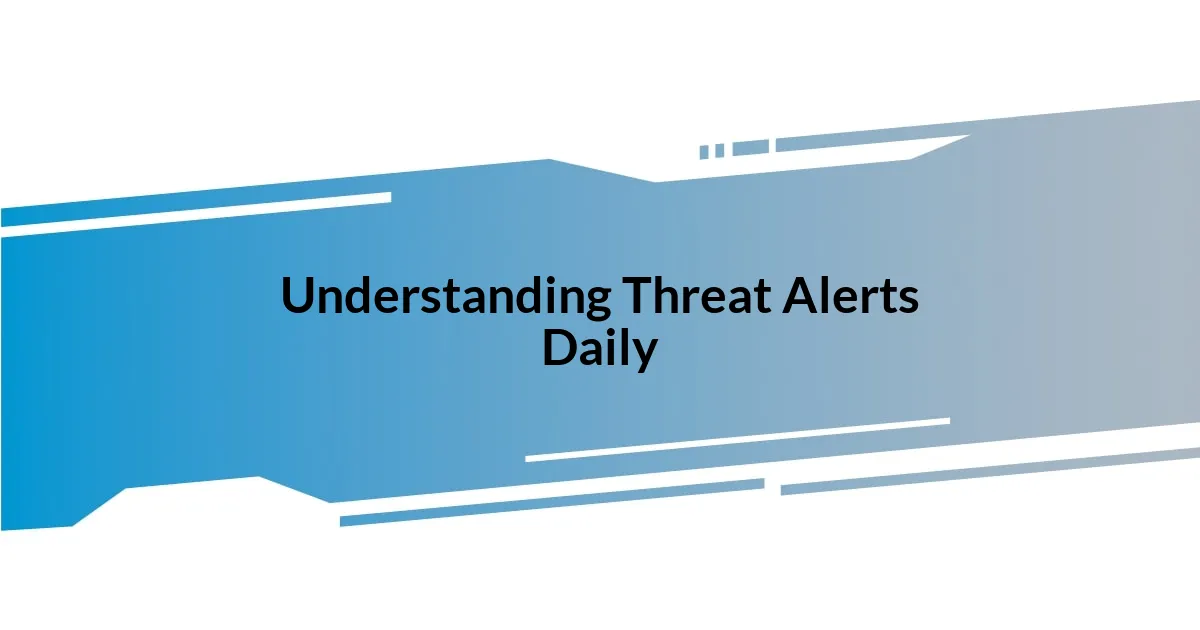
Understanding Threat Alerts Daily
Understanding the nuances of threat alerts is crucial for anyone tasked with cybersecurity. I still remember when I first encountered a sudden spike in alerts one morning; that panic was palpable. It’s moments like these that sharpen your instincts — how do you prioritize what’s real versus what’s noise?
Every day, I sift through alerts, each carrying potential implications for the organization. It can feel overwhelming at times, almost like navigating a maze where one misstep could lead to disaster. Have you ever felt that way? I know I have; understanding the context behind those alerts can turn a potential crisis into a manageable situation.
I often find that certain patterns emerge over time, helping me recognize which alerts require immediate attention and which can wait. For instance, a peculiar influx of requests from an unknown IP could indicate a breach attempt. This realization not only fortifies my focus but fosters a sense of determination in tackling these challenges head-on, turning fear into action.
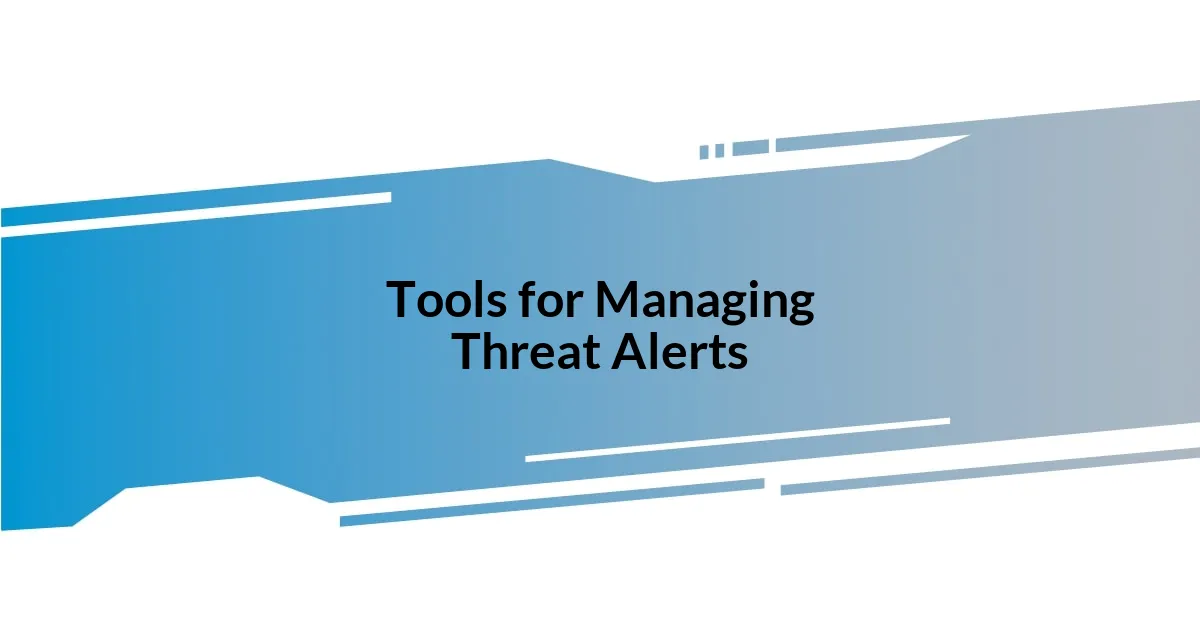
Tools for Managing Threat Alerts
When it comes to managing threat alerts, the right tools can make all the difference. Over the years, I’ve experimented with various platforms and systems, each bringing unique strengths and weaknesses to the table. One tool that has become my go-to is a robust Security Information and Event Management (SIEM) system. This interface serves as the nerve center for my threat detection, aggregating data from multiple sources to give a clearer picture of potential threats.
Here’s a quick overview of some essential tools I find invaluable:
– SIEM Systems: Aggregating and analyzing security data in real-time.
– Threat Intelligence Platforms: Providing context and insights into emerging threats.
– Intrusion Detection Systems (IDS): Monitoring network traffic for suspicious activity.
– Endpoint Protection: Protecting devices from malware and breaches.
– Incident Response Tools: Streamlining the process of responding to security incidents.
I’ve learned that robustness isn’t everything; usability matters too. There was this one time when I encountered an unfamiliar interface on a new software I’d integrated. I spent far too long fumbling around, trying to find where to adjust alert thresholds. That frustration taught me the importance of user-friendly designs in my tool selection. Having a clear, intuitive layout can save valuable time when responding to real-time threats, allowing me to focus on what truly matters: securing our digital landscape.
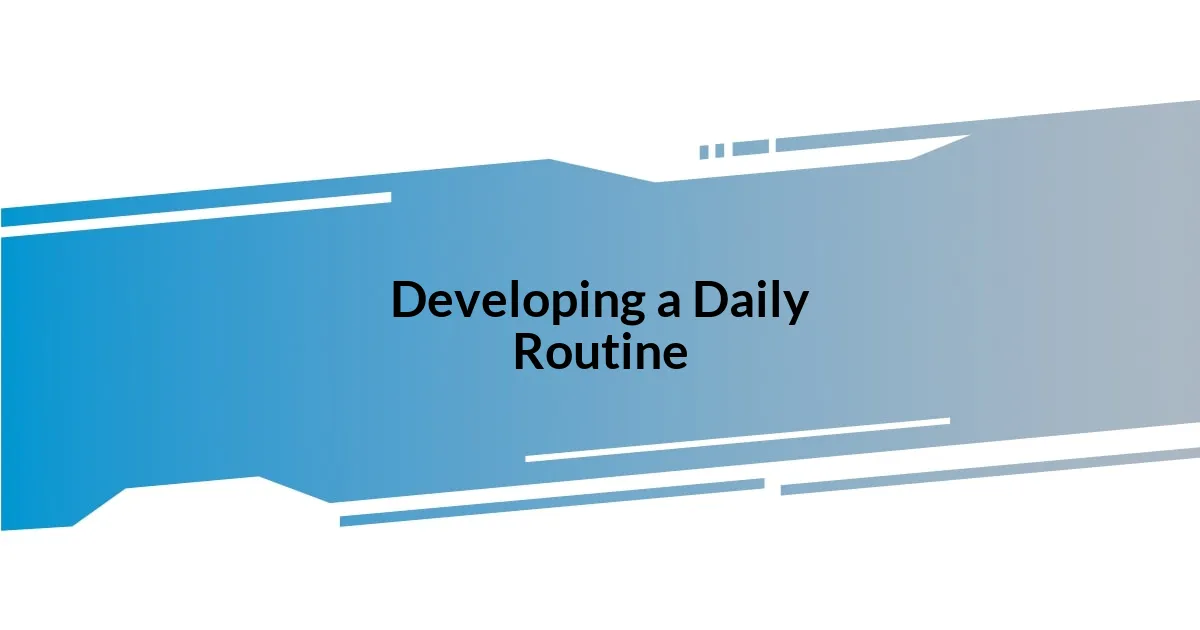
Developing a Daily Routine
Developing a daily routine for managing threat alerts is essential for maintaining focus and efficiency in cybersecurity. I like to start my mornings by reviewing any alerts from the previous night, and that first cup of coffee feels like a trusted companion on this journey. It sets the tone for the day, helping me approach alerts with fresh eyes. Having a dedicated time each morning allows me to prioritize and strategize my responses without feeling rushed.
Throughout the day, I break my routine into focused blocks of time. I allocate specific slots for reviewing alerts, responding to them, and adjusting alert settings based on the patterns I observe. It’s fascinating how a structured routine can help mitigate the stress of a high-paced environment. I remember the days when I would react to each alert as they came in, leading to unnecessary chaos. Now, with a steady approach, I’ve found a rhythm that not only enhances productivity but also eases my mind.
As I continue to refine my daily routine, I’ve learned the importance of flexibility. Some days demand more attention due to emerging threats, and that’s when I adapt my schedule. This balance of structure and adaptability has become my secret weapon. I often wonder if anyone else feels this way—how essential is it to blend routine with spontaneity in managing cybersecurity threats? From my experience, it can make all the difference in team morale and efficiency.
| Routine Element | Description |
|---|---|
| Morning Review | Check alerts from the night before; set priorities. |
| Focused Work Blocks | Allocate time for reviewing and responding to alerts. |
| Flexible Adjustments | Adapt the routine as new threats emerge. |
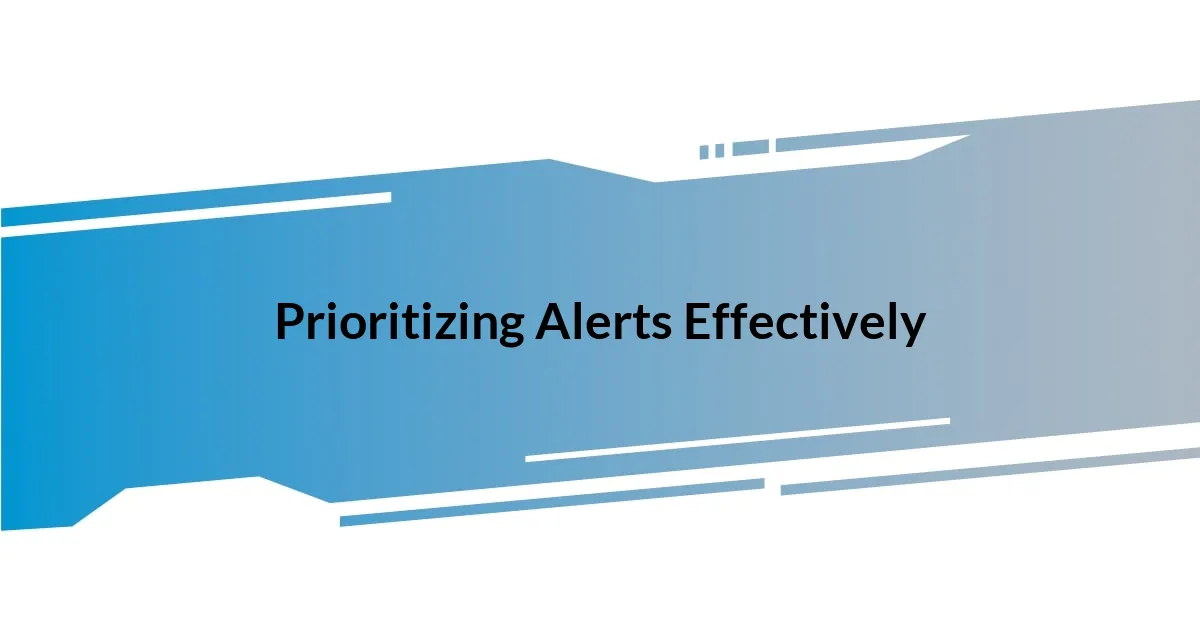
Prioritizing Alerts Effectively
Prioritizing alerts effectively can truly shape how I navigate the intricate landscape of threat management. When I first began, I often felt overwhelmed by the sheer volume of alerts. It was like trying to find a needle in a haystack! Then, I realized that categorizing alerts based on severity and impact was crucial. Now, high-risk alerts get immediate attention, while lower-priority items are scheduled for review later. This method not only prevents me from drowning in notifications but also allows me to focus on what could cause the most damage if neglected.
I still remember the day when a critical alert slipped through my fingers because I didn’t prioritize it properly. That incident left me feeling uneasy for weeks. Ever since then, I’ve implemented a triage system; it’s like a doctor assessing patients in an ER, ensuring the most critical cases are treated first. This approach fundamentally changed how I respond to alerts—it feels empowering to take control rather than react out of sheer panic.
Moreover, I engage my team in this prioritization process. We often brainstorm together to assess which alerts require immediate action. I’ve found that collaboration provides diverse perspectives and enhances our collective understanding. Have you ever noticed how different minds can illuminate aspects you might miss? This team dynamic strengthens our response strategy. By sharing insights and experiences, we not only stay better informed but forge a stronger bond within the team, ultimately creating a more robust defense against potential threats.
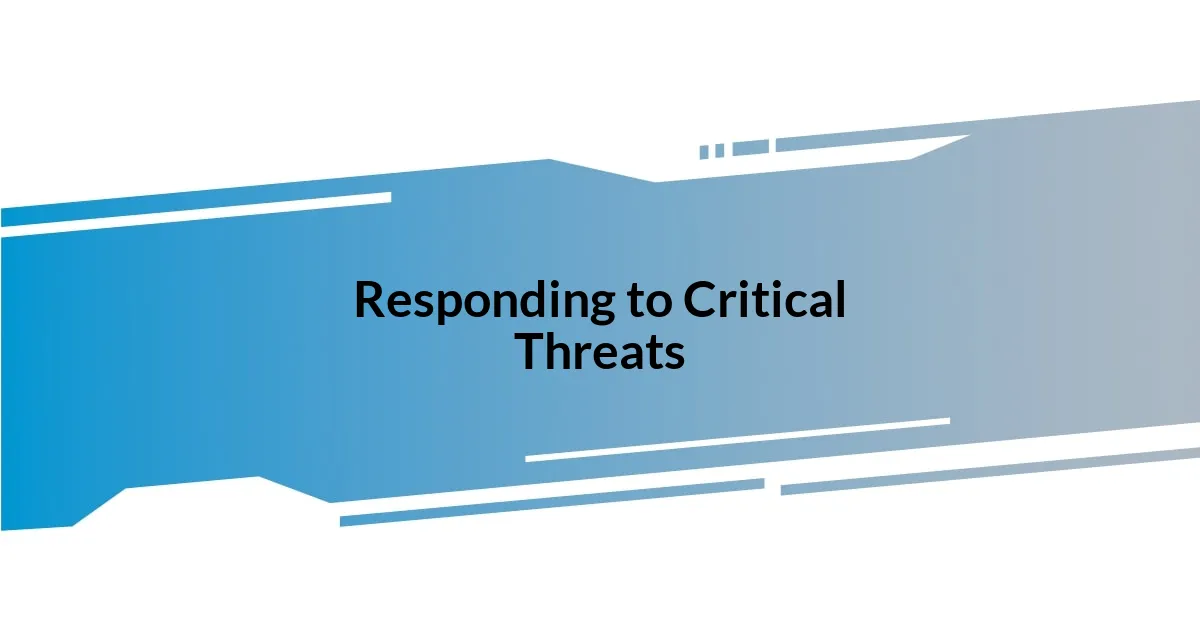
Responding to Critical Threats
Responding to Critical Threats
When a critical threat alert comes in, my heart starts to race. It’s in these moments that I realize the true weight of my work. I recall one instance where a major breach attempt was detected late at night; the adrenaline kicked in as I quickly assembled my team for a rapid response. This heightened sense of urgency transforms how I operate; every second counts, and I have to be laser-focused to mitigate the risk.
To respond effectively, I’ve found that communication is key. I make it a point to clearly delegate tasks based on each team member’s strengths, which really turns chaos into cohesion. I remember feeling so relieved when I designated one of my colleagues to handle external communications, allowing me to focus on technical responses. Have you ever experienced that feeling of synergy when everyone is playing to their strengths? It’s something I cherish in these intense moments.
After the dust settles, reflecting on the incident is crucial. I like to gather everyone for a debriefing session, discussing what went well and what we could improve. This practice not only fosters a culture of continuous learning but also strengthens our resolve as a team. I genuinely believe that these experiences shape our preparedness for future threats. It’s a reminder that every challenge, though daunting, is an opportunity for growth.
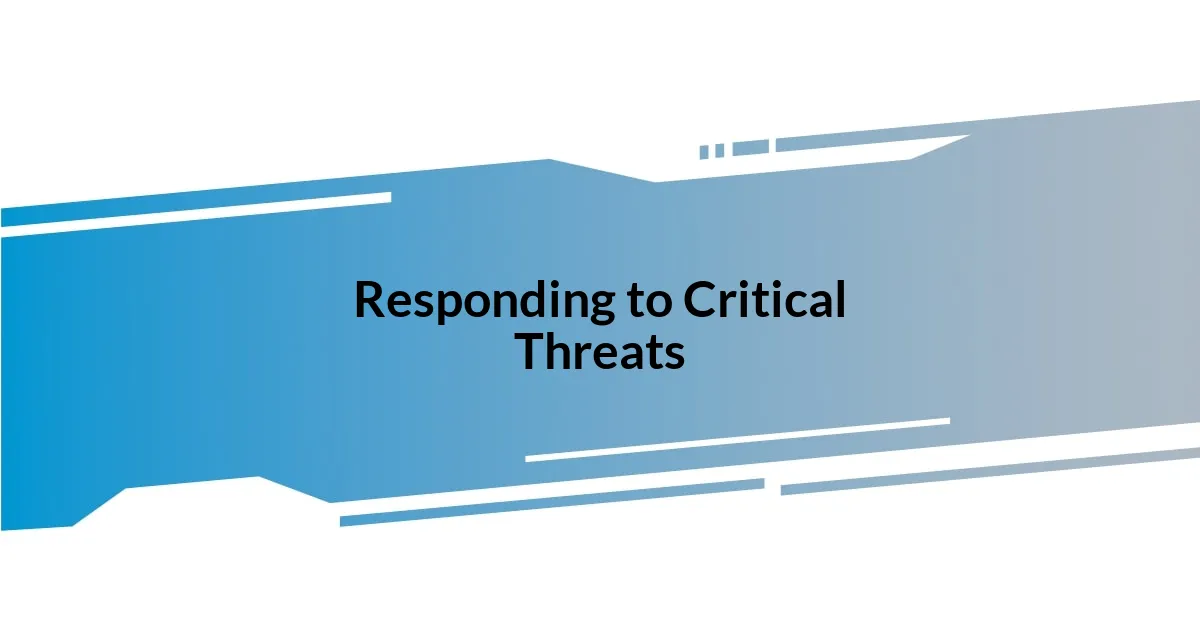
Reviewing and Analyzing Alerts
When it comes to reviewing and analyzing alerts, I take a methodical approach that has served me well. I’ve learned to categorize alerts not just by severity, but also by context—understanding what each alert truly signifies in terms of potential risk. I still remember a time when I misinterpreted a benign alert as critical, which turned out to be a false alarm. That experience taught me the importance of context and not jumping to conclusions without thorough analysis. Does anyone else find that a little pause for reflection can often prevent unnecessary panic?
I also dedicate time daily to comb through the alerts, not just responding but truly analyzing patterns over time. It’s fascinating to see what trends emerge and how they can inform our overall security posture. For instance, I noticed an uptick in phishing attempts targeting my organization last quarter. By spotting this trend early, I was able to coordinate a proactive training session for my team, which drastically reduced the number of successful attempts. Have you ever felt that satisfaction of turning data into actionable insights? That’s where the real value lies.
To facilitate this process, I often use visual dashboards that help me quickly spot irregularities and trends. Visualizations transform raw data into a story—one that speaks volumes about potential vulnerabilities. I can’t tell you how much easier it becomes to communicate findings with my team this way. When was the last time you made a decision based on a simple visual that resonated with you? It’s that impactful in our line of work. By enabling the team to grasp what’s at stake, we can engage everyone in a more multi-faceted response plan.
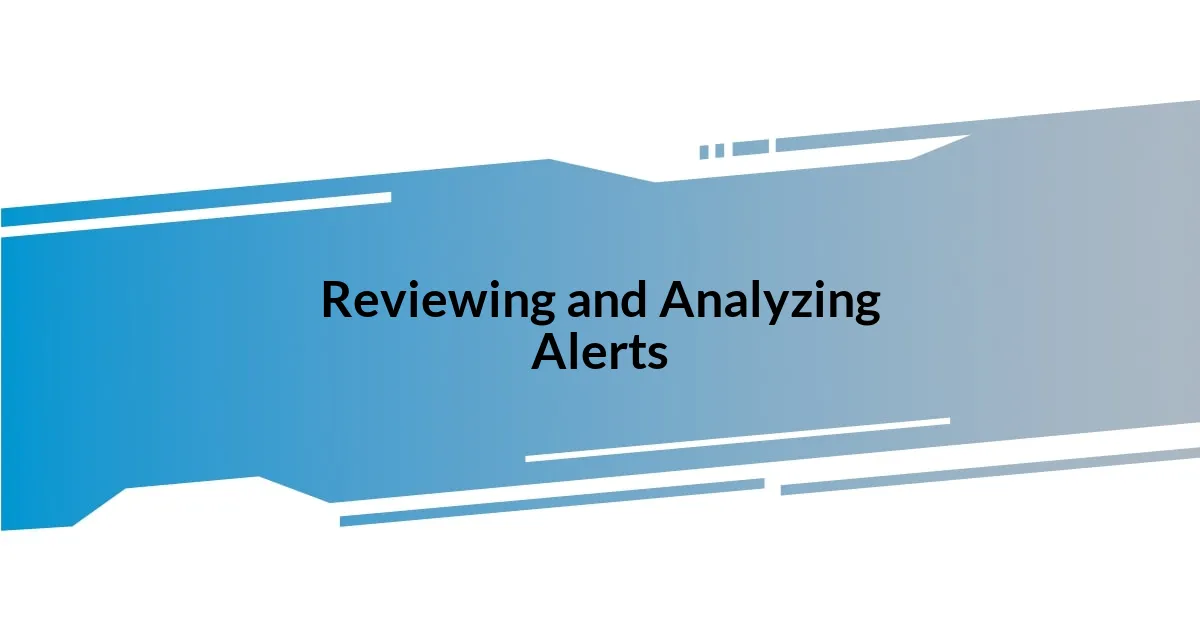
Continuous Improvement Strategies
The journey of continuous improvement in threat management is something I take to heart. One method that’s proven invaluable is the regular review of post-incident reports. I remember going through a particularly challenging month where we faced multiple breaches. Analyzing these incidents together with my team revealed some surprising gaps in our protocols. It’s moments like these that ignite a passion for refining our procedures. Have you ever discovered insights that completely shifted your perspective on your processes?
In addition to post-incident debriefs, I advocate for ongoing training. I’ve organized workshops where we role-play different scenarios, which leads to a practical understanding of our response techniques. One session stands out; as we simulated a ransomware attack, I was amazed at how my team came together, effectively communicating under pressure. It’s incredible how these exercises build confidence, wouldn’t you agree? They transform theoretical knowledge into actionable skills, making us more resilient in real situations.
Another effective strategy I employ is seeking external feedback. I often turn to industry peers and engage in forums to collect insights on best practices and evolving threats. One memorable discussion on threat intelligence sharing opened my eyes to collaborative approaches. It’s compelling to think that by sharing our experiences, we can collectively bolster our defenses. How often do you seek outside perspectives in your practices? I find that it not only enhances our strategy but also nurtures a sense of community among professionals facing similar challenges.